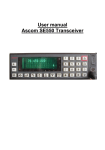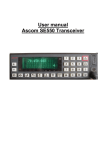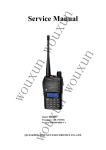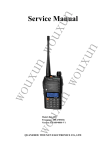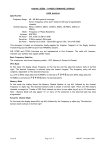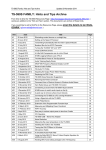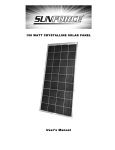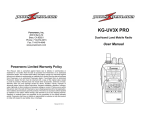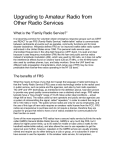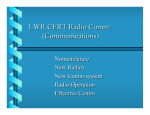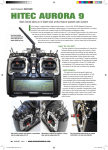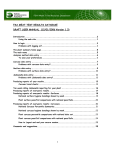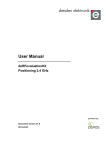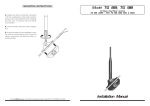Download Here - G3ZPF
Transcript
WOUXUN KV-UG950PL Updated 28 May 2015 The Wouxun KV-UG950P quad-band FM mobile rig was reviewed in RadCom recently. It covered 70cm/2/6/10m, as per a number of other quad band mobile rigs from various manufacturers but I noticed a mention on Martin Lynch & Sons website that a different version (suffix PL) covering 70cm/2/6/4m was expected to be on sale in a couple of months. I thought this would be a 3rd-party modification, swapping 10m for 4m but it turns out that ML&S had commissioned a custom version to be made by Wouxun (pronounced ‘oo-shun’, not ‘wux-un’) in their factory. Seeing a ham radio dealer persuading a maker to produce a customised batch of a rig is a new development in the amateur market (a miniscule market in the greater scheme of things), and a bold move by both parties in the wake of the ARRL failing in their recent attempt to get a 70MHz allocation. The replacement of 10m by 4m seemed a far better ‘fit’ for the UK market to me, certainly for base station use, so I decided to pre-order one. As predicted it arrived at the end of October. THE FIRST DAY Once out of the wrapping the build quality turned out to be very impressive. The whole case is a substantial heat-sink. Fig 1 : Front Panel Fig 2 : Side view with angled head adapter fitted As you’ll see in the photos the appearance of the front panel has a more ‘industrial’ look than the stylish curves of rigs from the Japanese equivalents, but has a similar layout to the models from other brands. Immediately obvious is the inclined face of the head unit. The angle can be reversed or by swapping the supplied adapter, aligned ‘flat’. A separation cable is supplied as standard, to allow the head unit to be located away from the main body and (unlike some rigs I’ve seen) the microphone is plugged into the head unit, not the base unit. Fig 3 : Top View Fig 4 : Bottom View The microphone plug is an RJ45 type. I’m personally not fond of them but it is a common choice for manufacturers of mobile gear. I always use a freezer bag tie to take the strain off the microphone plug because if you don’t then over time the pins inside the socket start to make intermittent contact resulting in scratchy audio on transmit. For base station use I imagine most people invert the mobile mounting bracket to use as a stand, and this is a convenient place to tie a makeshift strain relief. (Fig 6) Fig 5 : Supplied speaker-mic There is no knob on the front panel for squelch control. A menu sets the squelch level. I was unsure about this at first but in practice I have not found it to be an issue, especially as there is a ‘squelch defeat’ button below the PTT on the microphone. The microphone (Fig 5) sits well in the hand & in addition to the keypad contains a speaker that can be used instead of, or in addition to, the internal speaker in the main unit. The keypad is not just for DTMF use. You can control the entire rig from it. Fig 6 : Makeshift strain relief for mic plug for base station use with mobile bracket used as a stand. On the rear of the main unit you can fit separate external speakers for each ‘side’ of the rig. It is effectively two rigs in one, although (like other makes) the ‘right’ side only covers 2m and 70cm. There is a single SO239 aerial socket. As the rig covers UHF I’d have preferred to see an ‘N’ type socket fitted, but that’s just a personal choice. A mobile mounting bracket, microphone hook, and user manual, complete the roundup of what you get in the copious amounts of packaging. The manual might not be as visually ‘polished’ as some makers provide, but the information is all there, and even my old eyes can read it easily. The supplied manual is actually for the version with 10m at the moment, but read 70MHz for 28MHz and you’ll be fine. A few of the menu options (those which wont be used by amateurs) indicate this rigs ancestry in the professional PMR market, and that probably explains the rugged build quality. The menu tree is as extensive as similar rigs by the other makers & will take a while to get used to. Initially I found myself drowning in options/settings but an hour or so later I’d got it the way I liked it. A real surprise was finding the receiver covered the FM broadcast band. On 4/6/2m it will run 50w, reducing to 40w on 70cm. I fired it up on 4m and a local immediately came straight back with “You’ve got a new rig! Sounds just like you. Much better than your PMR box”, which was encouraging. The display has 3 colour options. Four if you include no backlight at all. As supplied it was set up use a different display colour for receive, busy channel, and transmit, which I wasn’t keen on so I changed it to green for everything. The build quality indicates some of the Chinese makers are getting their quality control act together. Martin Lynch said he investigated a number of Chinese makers before finally settling on Wouxun because their build quality was consistent. ONE WEEK LATER I’m starting to get used to the menu system now, and have gotten the hang of setting up and using memory channels. Something I never quite managed on my previous quad-bander. I decided to order a duplexer to avoid having to keep manually switching between my 4m vertical and my 2/70 colinear. If you decide to do the same you will need to check the specs to see where the hf/vhf switch occurs in the duplexer. The ‘Diamond’ brand ones all seem to switch at around 60 MHz, so I ended up going for the Comet CF530A where the switch between ports is at 90MHz (Fig 7) thus separating the 4m aerial from the 2m/70cm one. People using a 6/2/70 colinear will need to switch to a 4m aerial manually. Fig 7 : Comet CF-530 Duplexer Fig 8 : Internal view of the ‘600watt’ rated unit The Comet duplexer is rated at 600w but having looked inside (Fig 8) that power rating seems ‘ambitious’ to me. Easily good enough for the 50w out of this rig though. I’d have preferred to see an ‘N’ socket on the VHF/UHF side of the duplexer, but that’s me being picky again. In practice this unit works just fine and I haven’t detected any ‘leakage’ from one output port to the other, and no visible insertion loss or VSWR change noticeable on my two SWR bridges (I have one for each aerial). VHF types don’t seem to bother with power/swr meters but being primarily interested in HF I’d feel uncomfortable without one permanently in circuit. The cross-pointer meters provide immediate warning of aerial problems. Like most vhf rigs these days there is programming software freely available on the makers site, which I managed to download from Wouxun. Maybe I picked an especially busy time but the download speeds were very slow and as it turned out I need not have bothered. You’ll need a programming lead. The standard RJ45 socket on the side of the rig labelled ‘PC’ made me think this would be a simple RJ45 patch lead but it turns out to be an RJ45 to USB lead with a built-in serial to USB converter. You can find a variety of them really cheap on Ebay, but there is a ‘gotcha’ inasmuch as some have a pirate copy of the FTDI chip in them and there’s no way to tell. The internet has plenty of accounts of what misfortune can result if you end up with a lead containing a fake FTDI chip, so unless you’re sure of the supplier it pays to stick to the branded item. When my lead arrived it came with a CD containing the software, even though it wasn’t mentioned in the internet advert. It was a branded wouxun product so I had no problems with the FTDI chip. Fig 10 : Programming lead & Software The software is on a mini-CD. Not a problem for PCs with drives mounted horizontally. There is a recessed area in the centre of the tray for this purpose. But if you have a small format PC with the drive tray mounted vertically you need to ensure the locating clips are engaged before closing the drawer. While waiting for the lead to arrive I spent some time exploring the menu system and managed to lock myself out of the rig. Menu item 44 allows the rig to go into ‘remote control’ mode, at which point I presume you could control it from a PC. Unfortunately if you enable menu 44, but remote connectivity is not subsequently established, the firmware does not time-out so you are stuck. Switching the rig on & off doesn’t help. Switching the rig on while holding down any of the front panel knobs didn’t reveal a hard-reset mechanism either. But eventually I realised that whilst powering the rig up normally and then pressing the ‘#lock’ button didn’t appear to help, it does actually unlock the MENU button, so you can then disable remote control. That ‘gotcha’ does not happen if you have previously chosen to press the TDL button (so that only one side of the display is functional). In that situation a simple press of the MENU button brings up an ‘RC-OFF’ prompt and you’re home free. Speaking of menu options, although not specifically stated in the manual I found that some of them are ‘per rig’, some are ‘per side’, whilst others are ‘per band’. It doesn’t take long to figure out which applies and once you start using memory channels every single channel can be set with different options. The 999 memory channels are ‘per rig’. The ‘right’ side of the rig only covers 2m and 70cm so if you activate memory scanning on that side of the rig it will ignore any frequencies outside those bands. All memory locations seem pretty much like the ‘hyper memories’ on Yaesu rigs. They store frequency, deviation, repeater offset, power, plus any other options you can think of (CTSS, DCS etc). The manual seems to indicate you can have different ‘scan groups’ set up, with each side of the rig running through different memory channel sets, but I haven’t tried that yet. When in memory channel mode (as opposed to VFO mode) you can choose to display channel number, channel name (which you enter), or frequency + channel number. I mentioned the FM broadcast receiver mode previously. You can be listening to Radio 4 on one side of the rig, while monitoring a frequency (vfo or memory) on the other. If the squelch opens on the monitored channel, the FM radio audio is muted until a few seconds after the squelch closes again. You can listen to the radio while scanning, but there is a software bug that makes it less than 100% effective. When the squelch opens while scanning, the FM radio mutes, but when the scan resumes the FM radio audio is still muted. The workaround is to briefly press the PTT to stop the scan, at which point the FM radio is audible again, and you can restart the scan. I hope that can be fixed in a firmware update. In VFO mode the left & right sides of the rig operate rather differently. On the left side you can change bands & the rig remembers the last channel you were on in each band, plus power level, deviation width etc. Unfortunately the right side doesn’t. It defaults to 140.125 and 420.125 every time you change bands with wide deviation, 25kHz steps, and high power output. I can’t see any special reason for this being necessary so hopefully a firmware update can change it. Using memory channels instead of the vfo on the right-hand side of the rig gets around this. There is one memory function that I’d really like to see on this rig, and that is a ‘memory to vfo’ option. Having set the scanning up with memories on all calling channels if you want to move off the calling channel needs several button pushes. If it was possible to transfer the memory channel settings to vfo with a button press you could then use the tuning knob to move off the calling channel when you start a contact. This could be simply implemented by using the ‘squelch defeat’ button below the PTT button. While scanning, a short press stops the scan, with a second opening the squelch. I’d have thought it was possible for a long press to stop the scan and transfer the current memory channel into the VFO. Everyone seems to agree that the supplied microphone produces very pleasant audio. I find myself using the microphone to control all aspects of the rig, rather than the front panel buttons. The mic buttons are far easier to use with my thick fingers than the ones on my previous quad band rig, and I haven’t pressed any by accident while transmitting. I have found a firmware bug when the rig is in scanning mode. If the rig finds a channel active, the scan stops the rig correctly the display sometimes will be indicating the NEXT channel in your scan list. Thanks to the delay in resuming scan, you can end up transmitting and receiving on a different channel to the one indicated. At the outset I wasn’t keen about not having a squelch control on the front panel, but I still haven’t found it a disadvantage in practice. The volume controls are not analogue pots, but to be honest I only realised when I spotted a comment on eHam about the ‘P’ version of this rig stating that the steps were too coarse. To my ears the steps are just fine, unlike the ones on my old PMR rig. I did receive an email from one user who commented that the minimum volume level was too high. Again I haven’t found this to be the case on my rig. With volume level set to ‘1’ I can barely hear any audio at all. Experience with a Motorola DMR rig revealed that commercial rigs can have a minimum volume setting to prevent users accidentally turning the volume down to zero. This is software controlled, and referred to as ‘audio offset’ so it is possible that a too-loud setting could be corrected by the dealer. As an HF type I habitually use external SWR meters and this extends to vhf/uhf at chateau ZPF. Because of this I noticed something curious on 4m. As soon as I press the PTT on all bands except 4m the forward power meter kicks up normally but on 4m there is a about a quarter second delay. The only time this ‘latency’ will even be noticed is if someone asks you a question and you jab the PTT at the same time as you say ‘yes’ and then go back to receive. The first fraction of a second of each transmission on 4m is ‘lost’. In much the same way as on every rig if you have sub-audible tones enabled. You get the same effect on receive too, if you look hard enough. There is a very slight latency between a received signal registering on the S-meter and the audio starting. The fan noise on the Wouxun is slightly higher pitched (although no louder) than the fan on my FT7900 which I initially found slightly irritating, but I seem particularly sensitive to fan noise so I don’t think most people would even notice it. But there is one aspect of the fan operation which I like. The Wouxun fan blows forwards, but into the body of the rig, whereas my ft7900 fan blows forwards across the outside of the rig. For base station use this can result in a slight breeze on your face from the ft7900 that isn’t there on the Wouxun. The fan in the Wouxun has 3 settings. The options are (i) always on, (ii) on when PTT depressed, (iii) on when over-temp OR when PTT depressed. Compared to the PMR gear I previously used on 4m (an Ascom se550 which got very hot indeed), or the ft7900/8900 which got quite hot, the wouxun 950pl stays remarkably cool. The Wouxun has a range of step sizes when tuning. The steps are ‘per side’, not ‘per rig’ so you can have different steps on left & right sides. I did wonder about 6m (10kHz steps) when 4 & 2m are set to 12.5KHz. Not a problem with 25KHz on 70cm but luckily even when set to 12.5KHz steps you can manually enter any frequency you like on 6m or store 10KHz channels in the memories. The Wouxun seems at least as sensitive as my other vhf/uhf rigs, and more sensitive on 4m than my old PMR rig. In the UK most people on 4m FM use ex PMR rigs so I found I was giving far better signal strength reports than I received off them. When I eventually worked someone else using the same rig we exchanged identical reports. This brings me to something I’ve recently noticed on other rigs. Bear with me because it does relate to the Wouxun too. The Wouxun seemed more sensitive than my ft7900 below 145MHz. I spotted a QSO on 144.650 where one party was just Q5 but noisy on the Wouxun but switching to my FT7900 I couldn’t hear him at all. Even opening the squelch and listening carefully I could barely make out the odd word. Back up in the main FM section of 2m on the QSOs I monitored there was no obvious difference in sensitivity between the Wouxun and the FT7900. This rig has no country-specific transmit limits on 2m or 70cm, and hence no ‘automatic repeater offset’ tables but it is easy enough to set up repeater channel pairs in the 999 available memory channels. User selectable offsets, and shift direction, are available. PROGRAMMING SOFTWARE It is crucially important to download & install the serial/usb drivers for the programming lead onto your PC before plugging the lead into the usb port or installing the wouxun control software. If you do not, your PC will install what it thinks are the best drivers and lead you into a world of pain. The following two screenshots show what you are presented with when you first run the software. Fig 11 : Default software settings on Memory tab Fig 12 : Default software settings on VFO tab. Note reference to 10m instead of 4m In case it is not obvious, those screens show the default settings for the software, NOT the settings in your rig. As you can see, the programming software is a basic spreadsheet type application. It works, but it isn’t pretty. Some of the columns are not wide enough to show the headings correctly and for some reason they have chosen to display the spreadsheet in a fixed ‘frame’… so the horizontal scroll bar is disabled. I have no idea why they chose to do that I’ve only shown two of the available six screens (selected by tabs) because these are the ones you can come unstuck with, due to the fact that the software is really intended for the 950p, not the 950pl. Looking at Fig 11 you will see that two of the memory channels already have frequencies programmed into them. What I found out the hard way is that the first memory channel must be in the 70cm or 2m bands. Looking at Fig 12 you will notice there is no mention of 4m in the VFO settings. 10m is there instead, and this screen is where you can waste a lot of time. Initially I tried to enter frequencies for 4m in the 10m column, but the software was having none of it. Eventually (as you will see in Fig 14) I realised that for use with the 950pl you have to enter the 4m frequencies in the 6m column, and the 6m frequencies in the 10m column. Here are the settings I initially set my 950pl with Fig13 : Calling frequencies entered into the software, prior to uploading to the rig. At this point it seems appropriate to mention that when you first connect the rig to your PC you should always do a read from the rig before trying to do the first write. That checks the comms are OK, and presents you with the settings your rig currently has. Which you immediately save onto your PC because that is the file you edit to include your chosen frequencies, and not the ‘wouxun.kg’ file that comes with the software. I recently received an email from ON7IM indicating that despite having read my instructions he was unable to upload files containing 4m frequencies to his new 950PL. Suspecting a rig fault we exchanged config files. Mine uploaded to his rig just fine, but his wouldn’t upload to mine. After some head scratching we realised that he’d edited the default file supplied with the software but I’d edited the config file I downloaded from my 950PL so it seems that editing the default file supplied with the software and attempting to upload that to the 950PL will fail. Fig 14 : VFO settings tab with band positions for the 950pl. Note the places I had to enter 4m and 6m settings. SUMMARY Despite the few niggles I mentioned, and which I hope the makers can address with firmware updates, I am very pleased with this rig. The performance seems at least as good as other quad-band mobiles I’ve owned, and on 4m the receive performance is significantly better than ex-PMR alternatives or other amateur rigs which cover 4m FM. The control software would definitely benefit from some extra work for use with the 950pl, but hopefully the above notes will save others the time it took me to get to grips with it. Having taken the initiative to commission a custom production run, ML&S have decided that this version will only be available direct from them, or from a few dealers who re-sell ones they get from MLS. If you come across one of these rigs without the “ML&S Ltd” name engraved on the bottom (see Fig 4) then it is a grey import and you will be talking to China regarding any warranty issues. David (G3ZPF)









